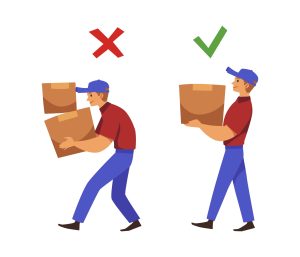This guide will discuss frequently asked questions regarding manual handling claims.
A manual handling injury can occur from lifting or moving heavy objects at work. However, in order to begin a personal injury claim following a manual handling accident at work, you need to show you meet the eligibility criteria. As such, to begin, we discuss when a compensation claim could be made against an employer for a manual handling accident.
We also cover other important aspects related to work-related claims, such as the time limit for starting a personal injury claim and how compensation can address financial losses as well as pain and suffering caused by the injuries you suffered in an accident.
As the guide progresses, you will get a clear overview of who is responsible for preventing manual handling incidents in the workplace and the legislation that needs to be adhered to.
Finally, we discuss how a No Win No Fee solicitor can assist you in seeking compensation for your manual handling injuries.
For more information, please contact an advisor using the details provided below. They can answer any questions you might have regarding your potential claim for free.
- Call 0800 073 8801.
- Contact us online.
- Use the live chat option below to talk to an advisor.

Select A Section
- What Are Manual Handling Claims?
- Who Is Liable For Manual Handling Claims?
- How Long Do You Have To Claim For Manual Handling Accidents?
- How Much Can You Claim For An Accident At Work?
- How Many Accidents Reported Under RIDDOR Are Caused By Manual Handling?
- What Legislation Applies To Manual Handling?
- How Are Manual Handling Risk Assessments Carried Out?
- No Win No Fee Manual Handling Claims
What Are Manual Handling Claims?
Manual handling refers to any activity where you lift, lower, carry, push, pull or otherwise move a load. A load is a movable object, such as a box or package but can also include a roll cage or pallet truck.
Your employer may ask you to perform manual handling tasks as part of your job. They have to ensure you are as safe as possible when doing these tasks. A manual handling compensation claim could potentially arise if they failed to do so leading you to become injured.
Call the number above if you have any questions about how to claim compensation for a manual handling accident.
Who Is Liable For Manual Handling Claims?
Section 2 of the Health and Safety at Work etc. Act 1974 (HASAWA) outlines an employer’s duty of care. They must take all reasonable and practicable steps to keep employees safe from harm at work and as they carry out their work-related duties. An employer could be responsible for an employee’s injury if they fail in this duty.
Furthermore, manual handling claims could be valid if the following eligibility criteria are met:
- The employer owed a duty of care.
- They breached their duty.
- This breach led to an accident where you suffered physical and/or psychological injury.
These three points set the definition of negligence in tort law. You need to have evidence of this in order to seek personal injury compensation.
Call us to discuss your specific case and find out whether you could make a manual handling claim for employer negligence. An advisor can offer guidance for free.
How Long Do You Have To Claim For Manual Handling Accidents?
The time limit set out by The Limitation Act 1980 means you have three years from the accident date to start a personal injury claim.
There are some exceptions to the time limit in some circumstances. For example, if a claimant lacks the mental capacity to take legal action after an accident, the time limit is paused indefinitely. A litigation friend could be appointed by the courts to make a claim on their behalf during this time. Alternatively, if they recover their capacity and no claim has been made for them, the three-year limit would begin from their recovery date.
Exceptions can also be made to the time limit if the person claiming is under the age of 18.
Call and speak to an advisor if you want to learn how long you have to start an accident at work claim. They can also share more information on manual handling injury claims, including whether one of our helpful and experienced solicitors could assist you in seeking compensation.
How Much Can You Claim For An Accident At Work?
The payout awarded following a manual handling compensation claim will depend on the specific circumstances of your case. Generally, though, you could be awarded a settlement comprising up to two heads of claim. These are general damages and special damages.
General damages is the primary head of claim compensating for the pain and suffering caused by your manual handling injuries.
Those responsible for calculating the value of your compensation claim can use medical evidence alongside the Judicial College Guidelines (JCG) to help them. This document includes guideline compensation brackets for different injuries, some of which you could experience because of a manual handling accident such as a back injury, a fractured ankle, and arm injury.
Compensation Table
The table below features guideline compensation figures that can be found in the JCG. However, please note that the top entry is not from the JCG. This table should only be used as a guide because manual handling compensation payouts vary from case to case.
| INJURY | SEVERITY | COMPENSATION GUIDELINES | NOTES |
|---|---|---|---|
| Multiple Serious Injuries Plus Special Damages | Serious | Up to £250,000+ | Compensation reflecting the pain and suffering of multiple serious injuries, physical and/or psychological, as well as financial losses such as a loss of earnings, care costs, and travel costs. |
| Neck | Severe (ii) | £65,740 to £130,930 | Damage to discs in the cervical spine causing disabilities that are considerably severe. |
| Severe (iii) | £45,470 to £55,990 | Severe soft tissue damage and/or ruptured tendons causing chronic conditions and a significant and permanent disability. | |
| Moderate (i) | £24,990 to £38,490 | Serious soft tissue injuries to the neck and back. | |
| Back | Severe (ii) | £74,160 to £88,430 | Nerve root damage with other issues, such as lost sensation. |
| Severe (iii) | £38,780 to £69,730 | Disc lesions or disc fractures as well as soft tissue injuries causing chronic conditions are covered in this bracket. | |
| Moderate (i) | £27,760 to £38,780 | Cases of damage to an intervertebral disc with some irritation to the nerve roots and reduced mobility. | |
| Arm | Less Severe | £19,200 to £39,170 | A substantial degree of recovery despite significant disabilities. |
| Elbow | Moderate or Minor | Up to £12,590 | Injuries that don’t cause any permanent function impairment or permanent damage. |
What Are Special Damages?
A secondary head of claim, called special damages, may also be included in a settlement. For example, if an injury suffered while lifting or carrying leads to financial losses, special damages can be awarded to compensate for these. For example, you could claim back:
- A loss of earnings if you are unable to work.
- Travel expenses.
- Domestic care costs.
- Home adaptation costs.
Keep track of your expenses by collecting documents including payslips, invoices, and bank statements.
Call our team on the number above to find out more about how compensation for manual handling claims is calculated and what you could potentially receive if you succeed with your case.

How Many Accidents Reported Under RIDDOR Are Caused By Manual Handling?
The Health and Safety Executive (HSE), Britain’s workplace health and safety regulator, provides helpful workplace accident statistics.
In 2022/23, these statistics show that employers reported 60,645 non-fatal injuries to employees under the Reporting of Injuries, Diseases and Dangerous Occurrences Regulations (RIDDOR). 17% of those injuries were related to handling, lifting or carrying.
However, not all of the manual handling injuries sustained at work during this period will have been caused by employer negligence.
If you were involved in a manual handling accident that caused injuries due to a breach of your employer’s duty of care, call today to find out what your options are.
What Legislation Applies To Manual Handling?
Whilst HASAWA is the central piece of health and safety legislation that outlines the general duty of care employers owe their employees, there are other pieces of legislation that set out the more specific responsibilities they have depending on the type of workplace they operate.
For example, The Manual Handling Operations Regulations 1992 sets out that employers should avoid the need for employees to carry out any manual handling activities that involve a risk of injury, if it is reasonably practicable for them to do so.
It further states that if manual handling operations that pose a risk of injury cannot be avoided, steps should be taken to reduce the risk involved. They should also carry out a risk assessment before any tasks are performed.
Examples of the ways they could reduce the risk of injury include:
- Providing manual handling training, such as giving guidance on safe lifting, so those carrying out the tasks can do so as safely as possible.
- Make any loads smaller or lighter as well as easier to grasp.
- Adapt the workplace to minimise carrying distances and avoid the need for unnatural lifting movements.
- Ensuring any work equipment provided to carry out manual handling tasks, such as a roll cage trolley, is safe and fit for purpose. Defective work equipment could contribute to a manual handling accident.
If their is a failure to adhere to the relevant legislation, and this causes a manual handling injury at work, you could have a valid accident at work compensation claim. Call the number above to find out more.

How Are Manual Handling Risk Assessments Carried Out?
Employers should assess the risk of any unavoidable manual handling task where injury is possible. Among the factors they should consider are the task, the load, the working environment and the capability of the individual. More specifically consideration should be given to:
- The weight of the load. Employers should be aware of manual handling weight limits when considering if a load is safe to carry.
- How far the load must be moved.
- The nature of the load. For example, if it’s hot, sharp, or slippery. Workers could be at risk of burns, chemical burns or other injuries if hazardous contents are spilled.
- The floor surfaces, lighting, and temperature. Manual handling injuries could occur if an employee slips, trips or falls while lifting and handling items.
- The employee’s strength, fitness and any underlying conditions, such as a pre-existing back conditions.
No Win No Fee Manual Handling Claims
Have you been in an accident at work due to employer negligence where you suffered manual handling injuries as a result? Get in touch today to learn if one of our specialist manual handling solicitors could help you.
If you’re eligible to instruct them to represent your case, they could offer their services under No Win No Fee terms by offering you a Conditional Fee Agreement (CFA).
Under a CFA, you typically won’t need to pay upfront or ongoing costs for the solicitor’s work. You also won’t need to pay for their services if the claim fails.
If the claim succeeds, you’ll pay a success fee from your compensation. This is usually deducted as a percentage with a legal limit. As such, you can ensure you receive the majority of your awarded settlement.
For more information on how an expert personal injury solicitor could help with manual handling claims, please contact an advisor. To do so, you can:
- Call 0800 073 8801.
- Contact us online.
- Use the live chat option below to talk to an advisor.

Other Resources On Workplace Accident Claims
Here are some further accident at work claim guides:
- Information on what to do after an accident at work, including starting a compensation claim.
- Our guide to injuries caused by understaffing at work and how much compensation could be awarded if you make a successful claim.
- Learn how to seek compensation if your colleague injured you at work and what steps you could take after the accident.
These resources could also help:
- Government information on claiming Statutory Sick Pay from your employer.
- NHS guidance on dealing with back pain and where you can get support.
- HSE tips on training for manual handling for employers.
Thank you for reading our guide on frequently asked questions about manual handling claims. Please call or contact us online if you have any other questions.



